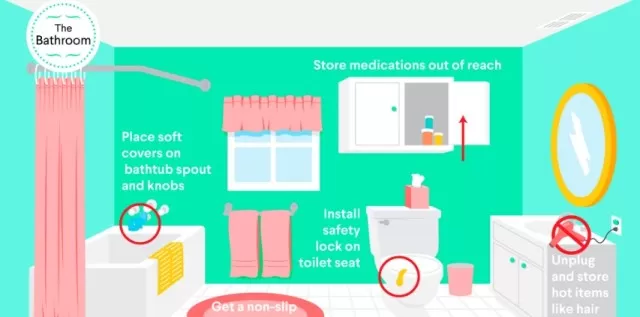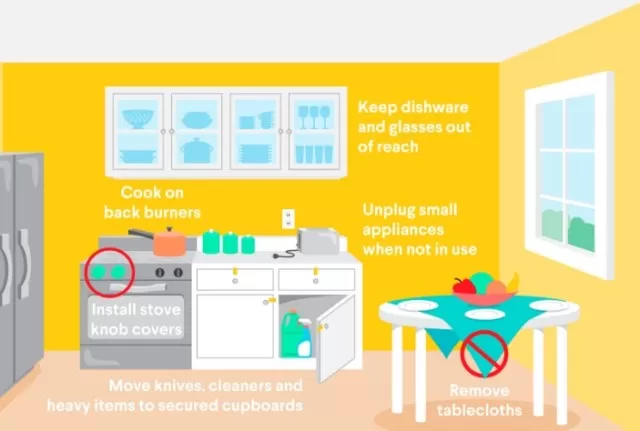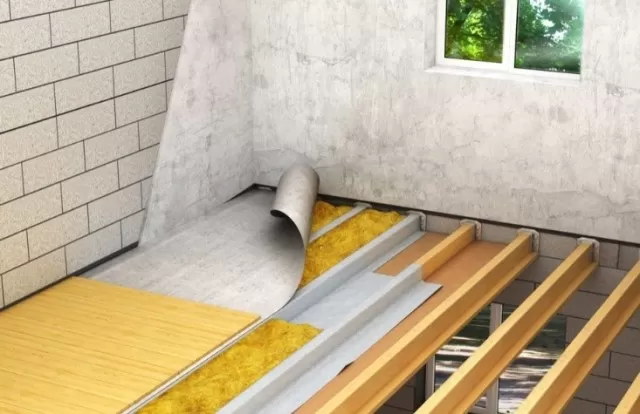Childproofing Essentials: A Comprehensive Checklist. Keeping your little one safe is a top priority. Remember, childproofing is an ongoing process as your child grows and explores new areas of the house. Regularly reassess and update your childproofing measures to ensure a safe environment for your little one.
Preparing Your Home for Your Baby’s Arrival: Ensuring Safety and Security

As you eagerly await the arrival of your baby, it’s essential to take proactive steps to create a safe environment.
While there are fundamental safety measures every home should adhere to, the imminent arrival of a baby amplifies their significance. In this article, we will not only emphasize the importance of these safety items but also provide additional recommendations to enhance the safety of your home for your little one.
Prioritize the functionality of your smoke and carbon monoxide detectors by ensuring they are in optimal working condition and equipped with fresh batteries.
With the arrival of your baby, it becomes increasingly challenging to remember routine maintenance tasks like battery replacements. Therefore, it’s crucial to address this before your little one comes home.
Evaluate your fire extinguishers and confirm that you have one readily available in both the kitchen and utility room.
This precautionary measure can significantly mitigate fire-related risks within your home.
Take a moment to assess your residence’s emergency preparedness by verifying the existence of multiple exit routes in case of a fire.
Having clear and accessible pathways can make a significant difference in swiftly evacuating your family to safety.
Safeguard your baby’s well-being by testing all the doors in your home.
Ensure that they close securely and cannot be opened without turning the doorknob. This precaution is particularly important for doors leading to potentially hazardous areas such as bathrooms, kitchens, staircases, the garage, or workshops.
Consider employing doorknob sleeves, which are readily available on platforms like Amazon, to further enhance safety in these areas.
While focusing on safety, don’t forget to double-check the temperature setting of your Water Heater.
Adjust it to a maximum of 120 degrees Fahrenheit to prevent scalding incidents. By taking this simple yet vital step, you create a safer environment for your baby during bath times and beyond.
By prioritizing these safety measures and going the extra mile to ensure your home is secure, you can provide a nurturing and protective space for your baby.
As you eagerly await their arrival, let the preparation of your home be an expression of your unwavering commitment to their well-being.
Childproofing for Crawling Babies and Curious Toddlers: Creating a Safe Haven
While your baby may have a few more months before they start exploring their newfound mobility, it’s never too early to start preparing your home for their adventurous escapades.
By taking a proactive approach and identifying potential dangers, you can ensure a safe environment for your little one to crawl, explore, and play. In this guide, we’ll walk you through important areas to consider and provide practical recommendations for childproofing your home.
Begin by conducting a thorough walk-through of your house, but this time, get down on all fours and crawl yourself.
This unique perspective will help you identify potential hazards that your baby may encounter as they navigate their surroundings.
One of the first areas to address is the kitchen and stairways.
Install safety gates to prevent your little explorer from accessing these potentially dangerous spaces. Remember, toddlers can be surprisingly resourceful and may attempt to climb up using chairs or other objects, so it’s important to secure these areas diligently.
Bathrooms can pose various risks, so keep all bathroom doors closed and inaccessible to your baby.
This measure helps prevent accidents involving water, cleaning products, medicines, and other potentially harmful substances.
Take extra precautions when it comes to toxic substances and hazardous items.
Lock up and store any poisonous substances, cleaning products, chemicals, medicines, fertilizers, alcohol, spices, tools, knives, lighters, or any items that could instantly harm your baby. Keep them high up and out of your little one’s reach to minimize the risk of accidental ingestion or injury.
Consider investing in a refrigerator lock or latch to prevent your baby from accessing its contents without supervision.
Likewise, stove dial covers provide an additional layer of protection against accidental burns or turning on the stove.
Electrical safety is paramount.
Cover unused electrical outlets with outlet plugs or sliding outlet covers, ensuring your baby cannot insert objects into them. Additionally, keep electrical cords out of your baby’s reach to prevent tugging or chewing on them, which can lead to electrical hazards.
Be mindful of securing curtain cords and cutting blind cords that are excessively long or form loops, as they can pose strangulation risks. Always keep blind and drape cords out of your child’s reach.
To prevent accidents or injuries, install childproof latches on drawers and cabinets that are not intended for your baby’s exploration.
Consider the layout of your cabinets and ensure that leaving a lower cabinet unlatched does not provide access to other locked cabinets. If necessary, rearrange your storage to eliminate potential hazards.
Take proactive steps to cushion sharp corners on furniture, cabinets, and counters.
This can be achieved by using corner guards or padding designed specifically for this purpose. By creating a softer environment, you reduce the risk of bumps and bruises during your baby’s exploratory adventures.
To enhance overall safety, secure furnishings, Wall Hangings, and shelves.
This can be done through wall anchors, brackets, or furniture straps, which provide stability and prevent tipping or falling objects.
By diligently implementing these childproofing measures, you’ll create a secure and nurturing environment for your crawling baby or curious toddler.
Regularly reassess your home’s safety as your child grows, ensuring that it remains a sanctuary where they can learn, play, and thrive with peace of mind.
Securing Furnishings, Wall Hangings, and Shelves: Eliminating Toppling Hazards

Childproofing your home involves being vigilant about potential hazards that can pose a risk to your child’s safety.
It’s crucial to address any items that have the potential to topple over and cause harm. In this section, we will discuss specific measures to secure furnishings, wall hangings, and shelves, ensuring a secure environment for your little one.
Begin by identifying furniture items that are top heavy or front heavy, such as televisions, dressers, stoves, refrigerators, bookshelves, tall lamps, or statues.
Install furniture straps, which are readily available on platforms like Amazon, to firmly secure these items. These straps help prevent tipping and provide added stability, reducing the risk of accidents caused by unstable furniture.
Take note of any wall hangings within your child’s reach and ensure they are well secured.
Use appropriate hanging hardware, such as sturdy hooks and brackets, to ensure these items will not come loose if tugged or pulled on by your little one. Regularly inspect the security of wall hangings to ensure their continued stability.
To prevent shelves from toppling over when your toddler attempts to climb them, it’s essential to anchor them to the wall.
Use brackets and screws to secure shelves firmly. In cases where shelves require extra support, consider utilizing toggle bolts for additional reinforcement.
These measures will minimize the risk of shelves detaching or falling, providing a safe environment for your child.
Bathroom Safety Measures:.
Always keep bathroom doors closed to restrict access and prevent unsupervised exploration.
Never leave a child unattended in the bathtub.
Accidents can occur quickly, even in shallow water, so constant supervision is essential during bath time.
Invest in toilet lid locks to prevent your child from opening the toilet and potentially falling in or encountering hazards like drowning, flushing objects, or exposure to unsanitary conditions.
Ensure that the water temperature in the bathroom is set below 120 degrees Fahrenheit to prevent scalding incidents.
Test the water temperature before your child’s bath to ensure it is safe.
Be cautious with buckets filled with water.
Never leave a bucket unattended, as even a small amount of water can pose a drowning risk for young children. Empty and store buckets properly after use to eliminate this potential hazard.
By implementing these precautions, you create a secure and child-friendly bathroom environment that minimizes the risk of accidents or injuries.
Remember, continuous supervision is crucial to ensuring your child’s safety in and around the bathroom.
Ensuring Pool Safety: Protecting Your Child from Accidental Drownings
When it comes to child safety, pool areas require utmost attention and rigorous precautions.
Accidental drownings are a significant cause of child fatalities, emphasizing the need to implement comprehensive safety measures. In this section, we will discuss essential steps to safeguard your child from accessing the pool without adult supervision.
Begin by carefully examining all doors that lead to the pool area.
Verify that they are equipped with automatic safety locks positioned out of reach of small hands. These locks should be designed to prevent unauthorized access, ensuring that your child cannot open the doors leading to the pool without the assistance of an adult.
Consider installing a pool alarm system, which serves as an additional layer of protection.
Pool alarms, available from various retailers including Amazon, provide an audible alert if someone enters the pool area, helping you respond promptly and prevent potential accidents.
To further enhance safety, install secondary gates within your yard to act as barriers, preventing your child from accessing the pool area unsupervised.
These gates should be securely positioned and designed to be child-resistant, ensuring that your little one cannot easily maneuver past them.
Regularly inspect the gates and fences surrounding your pool area to ensure they meet safety standards.
Check that the height, height off the ground, slat width, and latch position and design comply with the recommended guidelines. By adhering to these standards, you create an effective barrier that minimizes the risk of unwanted entry to the pool area.
In addition to these precautions, it’s crucial to emphasize the importance of constant adult supervision whenever your child is near the pool.
Keep in mind that no safety measure can replace the need for diligent supervision and attentiveness.
By diligently implementing these pool safety measures, you significantly reduce the risk of accidental drownings and create a secure environment for your child.
Remember, pool safety is an ongoing commitment, so regularly reassess and update your safety measures as your child grows and develops new abilities.
Ensuring Safety with Baby Gear: Meeting Standards and Exercising Vigilance

When it comes to selecting and using baby gear, prioritizing safety is paramount.
By following guidelines established by the Consumer Product Safety Commission (CPSC) and staying informed about product recalls, you can make informed decisions and create a secure environment for your child. However, it’s important to recognize that your vigilance and caution as parents and caregivers play an integral role in keeping your children safe.
.
To begin, when purchasing baby gear, ensure that each item meets the standards set by the CPSC.
These standards encompass a wide range of products, including cribs, strollers, car seats, high chairs, playpens, and more. By choosing products that adhere to these guidelines, you increase the likelihood of providing your child with safe and reliable gear.
Additionally, regularly check the CPSC website for product recalls.
The CPSC frequently releases recall information to alert consumers about potential safety concerns with specific baby products. Staying informed and promptly responding to any recalls is crucial for the well-being of your child.
Visit the CPSC website regularly and consider signing up for recall notifications to stay up to date on any important safety alerts.
While adhering to safety standards and being aware of recalls is essential, it’s equally important to exercise constant vigilance and caution as parents and caregivers.
No safety standard or recall notice can replace the watchful eye and responsible judgment of an attentive adult. Stay within arm’s reach of your child whenever they are using baby gear, and never leave them unattended.
Regularly inspect and maintain your baby gear to ensure it remains in optimal condition and functions as intended.
By combining your awareness of safety standards, vigilance regarding product recalls, and unwavering caution as parents and caregivers, you create a secure environment for your child.
Remember, your active involvement and proactive approach play a crucial role in keeping your child safe while using baby gear.
*The information is for reference only.